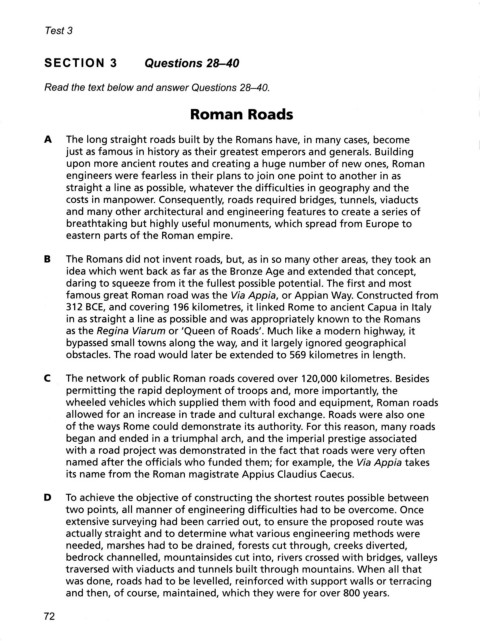Page 367 - Cam General 15-16-17-18-19
P. 367
Test3
SECTION 3 Questions 2ι40
Read the text below and answer Questions 28-40.
Roman Roads
A The long straight roads built by the Romans have, in many cases, become
just as famous in histo「y as their greatest emperors and gene「als. Building
upon mo「e ancient routes and creating a huge number of new ones, Roman
engineers were fearless in their plans to join one point to another in as
straight a line as possible, whatever the difficulties in geography and the
costs in manpowe仁 Consequently, roads required bridges, tunnels, viaducts
and many other architectural and engineering features to create a series of
breathtaking but highly useful monuments, which spread from Europe to
eastern pa 内s of the Roman empire.
B The Romans did not invent roads, but, as in so many other areas, they took an
idea which went back as far as the Bronze Age and extended that concept,
daring to squeeze from it the fullest possible potential. The first and most
fam。us great Roman road was the Via Appia, or Appian Way. Constructed from
312 BCE, and covering 196 kilometres, it linked Rome to ancient Capua in Italy
in as straight a line as possible and was appropriately known to the Romans
as the Regina Viarum or ’Queen of Roads’. Much like a modern highway, it
bypassed small towns along the way, and it largely ignored geographical
obstacles. The road would later be extended to 569 kilometres in length.
C The network of public R。man roads covered over 120,000 kilometres. Besides
permitting the rapid deployment of troops and, more importantly, the
wheeled vehicles which supplied them with food and equipment, Roman roads
allowed for an inc「ease in trade and cultural exchange. Roads were also one
of the ways Rome could demonstrate its authority. For this reason, many roads
began and ended in a triumphal arch, and the impe「ial prestige associated
with a road project was demonstrated in the fact that roads were very often
named after the officials who funded them; for example, the Via Appia takes
its name from the Roman magist「ate Appius Claudius Caecus.
D To achieve the objective of constructing the shortest routes possible between
two points, all manner of enginee「ing difficulties had to be overcome. Once
extensive surveying had been ca 「「ied out, to ensu 「e the proposed route was
actually straight and to determine what various engineering methods were
needed, marshes had to be drained, forests cut through, creeks diverted,
bedrock channelled, mountainsides cut into, rivers crossed with bridges, valleys
traversed with viaducts and tunnels built through mountains. When all that
was done, roads had to be levelled, reinforced with support walls or terracing
and then, of course, maintained, which they were for over 800 years.
72

